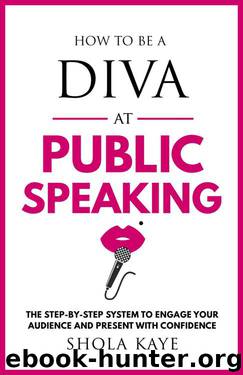How to be a DIVA at Public Speaking: The step-by-step system to engage your audience and present with confidence by Shola Kaye

Author:Shola Kaye [Kaye, Shola]
Language: eng
Format: epub
Published: 2017-02-19T22:00:00+00:00
Another important consideration is the VAK system. I mentioned this in Chapter 4 on being INSPIRING. Most people process information in one of three different ways. They may be visual, auditory or kinaesthetic. Visual people need to hear expressions like "Do you see what I mean?". Auditory learners are stimulated by language such as "I can hear what you're saying" while kinaesthetic learners are more focused on feelings. For example, "I can feel where you're going with this", or “My gut reaction is to agree". Try to mix up your language so that you touch all three groups.
How will you open and close?
In Chapter 2 we talked about the energy of your open and close. The content of these two sections of your talk is important too. Remember that your opening can create value for your audience. The right question or quote can frame the entire speech, putting everything you say in context.
Now we take a more in-depth look at your close.
Regarding your close
In my years of performing on stage, I always took it as a slight affront if the crowd didn't ask for a couple more songs at the end of my set. During a musical performance, people can let you know if they want an encore by shouting out "One more!" It's not the same when you’re making a speech.
In speaking, the audience show their appreciation with a standing ovation or some hearty cheers. Help them out by providing them with an inspiring ending they can appreciate.
Closing your speech is an art. Many people go in with a bang and out with a whimper. Don't spoil a perfectly good speech by ending abruptly and sidling off the stage with an embarrassed look on your face.
In his book Instant Speaking Success, the American speaker Paul Evans says, don't close a speech. Instead, 're-open' it.
End your speech on a high and hopeful note. In a way, the end of your speech is just the beginning for the audience.
Imagine you've just run your lap of a relay race and you're now handing over the baton to the members of the audience. You're urging them to take your information, apply it, and execute on the call to action. You're encouraging them to run a race that might even change their lives. Therefore, it could be the start of something big for them. Your close should end with hope, with energy, with an air of possibility, and a sense of “What's next?”
A good way to end is with a recap of what you've covered. You can say "In conclusion" or "As I come to the end of my talk..." or something similar. Then précis your content with a summary of your top three points (or fewer depending on how much time you have). You then want to make your call to action.
Earlier in this book, I discussed the idea of having a core message, a throughline or a foundational phrase that summarises the essence of what you want the audience to take away.
Download
This site does not store any files on its server. We only index and link to content provided by other sites. Please contact the content providers to delete copyright contents if any and email us, we'll remove relevant links or contents immediately.
Cecilia; Or, Memoirs of an Heiress — Volume 1 by Fanny Burney(32436)
Cecilia; Or, Memoirs of an Heiress — Volume 2 by Fanny Burney(31872)
Cecilia; Or, Memoirs of an Heiress — Volume 3 by Fanny Burney(31857)
The Lost Art of Listening by Michael P. Nichols(7409)
Asking the Right Questions: A Guide to Critical Thinking by M. Neil Browne & Stuart M. Keeley(5649)
We Need to Talk by Celeste Headlee(5545)
On Writing A Memoir of the Craft by Stephen King(4863)
Dialogue by Robert McKee(4323)
Pre-Suasion: A Revolutionary Way to Influence and Persuade by Robert Cialdini(4151)
I Have Something to Say: Mastering the Art of Public Speaking in an Age of Disconnection by John Bowe(3842)
Elements of Style 2017 by Richard De A'Morelli(3307)
The Book of Human Emotions by Tiffany Watt Smith(3238)
Fluent Forever: How to Learn Any Language Fast and Never Forget It by Gabriel Wyner(3031)
Name Book, The: Over 10,000 Names--Their Meanings, Origins, and Spiritual Significance by Astoria Dorothy(2940)
Good Humor, Bad Taste: A Sociology of the Joke by Kuipers Giselinde(2904)
Why I Write by George Orwell(2877)
The Art Of Deception by Kevin Mitnick(2736)
The Grammaring Guide to English Grammar with Exercises by Péter Simon(2711)
Ancient Worlds by Michael Scott(2627)
